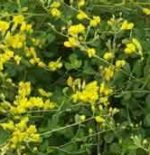 Horsefly weed is a shrubby herbaceous perennial native to eastern US from Maine to Minnesota south to Georgia and Iowa where it grows in dry meadows, fields and open woodlands. It is a member of the pea family, Fabaceae, that also includes lupine, mimosa, and black locust. Plants grow 2-3′ tall from a taproot and have erect, smooth stems bearing blue-green trefoil leaves with three leaflets up to 1/2″ long. The cream to yellow peas-like flowers and are carried in sparsely flowered racemes 1.5-5″ long from late spring to early summer. Each flower is 1/2″ long and gives way to a inflated seed pod containing several seeds. When the pods are shaken the seeds rattle giving rise to another common name, rattleweed. Because the flowers are less showy than those of other Baptisias, the plant is best used in a naturalized setting. The genus name, Baptisia, comes from the Greek word bapto meaning to dye and refers to the use of the plant as a substitute dye for indigo. The specific epithet, tinctoria, comes from the Latin word tingo meaning to dye, and is used to emphasis the use of this species as a dye.
Horsefly weed is a shrubby herbaceous perennial native to eastern US from Maine to Minnesota south to Georgia and Iowa where it grows in dry meadows, fields and open woodlands. It is a member of the pea family, Fabaceae, that also includes lupine, mimosa, and black locust. Plants grow 2-3′ tall from a taproot and have erect, smooth stems bearing blue-green trefoil leaves with three leaflets up to 1/2″ long. The cream to yellow peas-like flowers and are carried in sparsely flowered racemes 1.5-5″ long from late spring to early summer. Each flower is 1/2″ long and gives way to a inflated seed pod containing several seeds. When the pods are shaken the seeds rattle giving rise to another common name, rattleweed. Because the flowers are less showy than those of other Baptisias, the plant is best used in a naturalized setting. The genus name, Baptisia, comes from the Greek word bapto meaning to dye and refers to the use of the plant as a substitute dye for indigo. The specific epithet, tinctoria, comes from the Latin word tingo meaning to dye, and is used to emphasis the use of this species as a dye.
Type: Herbaceous perennial
Bloom: Racemes of cream to yellow pea-like flowers from late spring to early summer
Size: 2-3′ H x 2-3′ W
Light:Sun
Soil: Average, moist to dry, well-drained
Hardiness: Zones 3-9
Care: Prune to maintain rounded form
Pests and Diseases: None of significance
Propagation: Seed
Companion Plants: Shasta daisy, Indian blanket flower, black eyed susan,